Canning Soup: Adapt Your Recipe to Make It Safe for Home Canning
This page may contain affiliate links. More Information.
Canning soup at home is a wonderful way to have quick lunches ready. There are just a few things to remember:
- Can you can soup without a pressure canner? No, soups will always need to be pressure canned.
- Do not add noodles, rice, flour, cream, or any milk or thickeners. All of these can be added when you heat the soup to serve it.
- If you are using beans or peas, they must be cooked prior to canning.
- The only ingredients you should use are ingredients that are safe to can. So that means since cabbage does not have a tested method of canning just by itself, it is not considered an acceptable ingredient. (I know! I hate that!) Sauerkraut is a pickled item, so that is different than canning just plain cabbage.
- With these considerations in mind, canning vegetable soup at home is possible.
- I have a recipe for canning homemade chicken soup on this page.
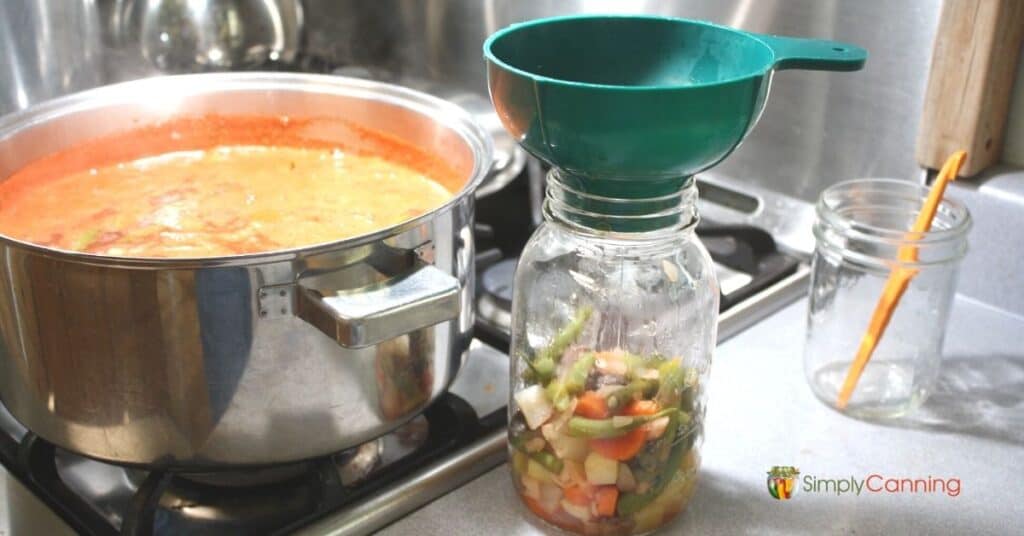
This Page Includes:
- Canning Soup: Extended, Step-By-Step Directions
- Recipe Card
- {Video} Canning Soup Tips
- {FAQ} What About Canning Cream Of Soups, Butternut Squash Soup, Tomato Soup, & Other Pureed Soups?
- {FAQ} Home Canning with Seasonings
- {FAQ} How Much Liquid to Put in the Jar?
- {Video} Can Vegetables Be Fully Cooked for Home Canning Soup?
- {FAQ} Canning Venison Soup
- {FAQ} Canning Potato Soup
- {FAQ} More on Canning Pureed Soup
- {FAQ} Some Oil/Grease Left in the Soup?
- {FAQ} Can I Add Sour Cream While Canning Soup?
- {FAQ} How Long Will Homemade Soup Last in a Canning Jar Once Processed?
- Members’ Extra
Canning Soup: Extended, Step-By-Step Directions
First, cook any meats and vegetables. (Remove bones after cooking.)
If you are canning soup with beans, cook them by covering dried beans with water by a couple of inches. Bring to a boil and simmer for 2 minutes. Remove from the heat and let soak for at least 1 hour. Drain.
Combine all solid ingredients and add whatever broth you may be using: chicken broth, beef broth, canned tomatoes, or water. Add spices and seasoning at this point as well. (See below for an important tip on seasonings.) You need at 2 times more liquid than solid ingredients.
Bring to a boil and simmer for 5 minutes.
Remember: No dairy, thickeners, pasta, or rice when canning soup. These ingredients can be added later when you serve the soup.
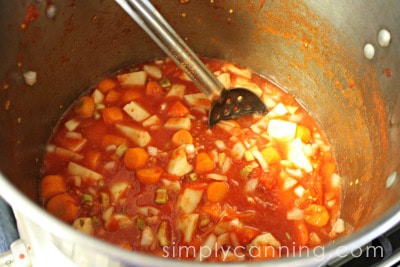
Fill your jars. Fill each jar about halfway full with the solid ingredients. (I use a slotted spoon.) Then add the liquid to cover, leaving a 1-inch headspace.
There is a safety reason for this half solids and half liquids recommendation. The gist of it is that you want the heat to penetrate fully to the center of the jar. If your soup is too thick, it may not do so. With the wide variety of ingredients possible with these adaptation directions…half solid/half liquid will ensure that your ingredients are heated through.
In this image, you can see several jars where I’ve added the solids, then one jar on the right where I’ve added the liquid.
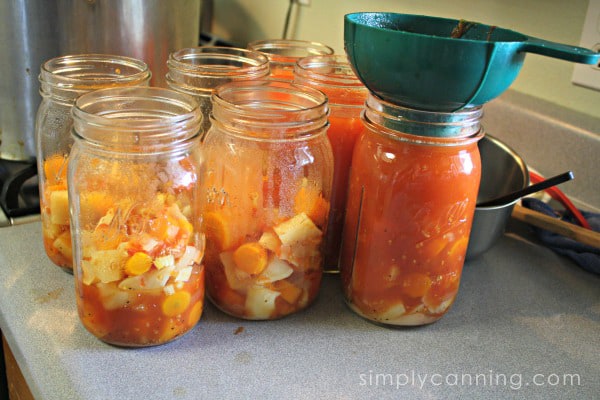
Having extra liquid can also be helpful if you’ll be adding noodles or rice when you serve it. (Don’t put noodles or rice in the jar! Canning soup a little…soupy…is a good thing.
Home Canning Vegetable Soup
Place your lids and process following pressure canning instructions.
Process pints 60 minutes, quarts 75 minutes. (If you are canning soup with seafood, you will need to process either pints or quarts for 100 minutes.)
Be sure to adjust processing according to your altitude using the charts below. For more information see this altitude adjustments page.
Recipe Card
Canning Soup Tips & FAQs
Canning Potato Soup
“Sharon, I made a big Crockpot full of potato soup, and all that was left I decided to can for later…when I opened one of the jars it was spoiled…what did I do wrong?? I love checking your site for different ideas and recipe… please keep them coming, and in advance, thank you for your help with this.“
Answer:
It is hard to say without knowing just what was in your soup and how you processed it. My guess is you have cream or some other dairy in your soup. And unfortunately, that is not recommended for canning.
More on Canning Pureed Soup
“Hello Sharon, I have read that you should not be canning pureed soup and I am wondering if this is true and why not? Also if I make vegetable soup and put small, cooked pasta in it, can that be canned? Thank you for sharing your knowledge and your support.
Answer:
Karen, it is true that canning pureed soup is not advised. There have been no tests done to determine safety. It all has to do with the density of purees. What you can do is can your ingredients and then puree the soup when you serve it. Use regular safety measures like any other canned soup.
And it is also true that pasta has not been tested for safety in home canning. I get comments all the time saying that since commercially canned soups contain pasta, we can do it also. But the issue is equipment.
Commercial processes use different equipment than home canners have available. We cannot assume that if we can buy soups with pasta or rice that it is still safe to add the same ingredients for home canning also. It is not.
Some Oil/Grease Left in the Soup?
“I canned some vegetable soup with turkey sausage. I followed the USDA website canning guidelines for canning soup. The soup has set for 24 hours, and I have removed the screw bands and checked the seals, which are good. However, I have noticed that there is a slight oily layer on top of the soup. I drained the turkey sausage before adding it to the soup, but obviously did not get it all. I have read that fat cannot be safely canned, but is a very slight oily layer on top okay?“
Answer:
Yes, when you are canning soup with meat, there may be some oils left in your soup. That is fine. You do want to get as much fat out as you can, but some may remain. As long as you drained the meat and followed all the other safety precautions, it is not a problem.
Can I Add Sour Cream While Canning Soup?
“I have a wonderful recipe for potato soup, which has quickly become a favorite in our household. I have canned chili, stews and other soups, but not sure on this recipe. It calls for 3/4 c of sour cream for one batch. Can I safely add this to my soup, then can it? Just not sure if the sour cream would break down during the pressure process. Thanks! Elizabeth”
Answer:
Elizabeth, it is not recommended that you can anything with dairy products. What I would do is try canning it without the sour cream or any other dairy, instead adding those ingredients later when you serve it.
Potato soup is a favorite at our house too. I almost always make it after a ham dinner with the leftover mashed potatoes and ham gravy as a base. My secret ingredient is chicken broth. The broth adds a wonderfully rich flavor. YUM!
How Long Will Homemade Soup Last in a Canning Jar Once Processed?
Generally, most home canned goods will last for at least a year. You can still use the soup, even if it has been longer than the 1-year mark, but the quality starts going down at that point. So if it has been a year, don’t throw it away! Just pull it to the front of the cupboard and make a plan to use it up soon.
It is not recommended that you can pureed-style soups, so I do not give directions for this.
However, what I would do is make the soup and can it prior to pureeing! Just can it chunky (kind of like canning vegetable soup). Then when you open the jar to serve it, puree it at that point. Simple solution!
Remember, some seasonings get strong when canned. For instance, sage is one that is noted for getting too strong. If you use bay leaves in your soup, be sure and remove them before you jar it up. The particular jar that ends up with the leaf will be very strong if you leave it! I keep our seasonings very simple. Salt and pepper are what goes in most things in my pantry.
In the directions, you’ll notice I state to first fill your jar half of the way with solids, and then top them off with your liquid. Filling each jar about halfway full with solid ingredients is a safety issue. Please do not skip this. If you have half solid and half liquid, the heat will penetrate fully throughout the jar.
Be sure you have enough broth that you will be able to cover the solid ingredients in the jar. You’ll want twice the amount of liquid to solid ingredients. If you realize you will not have enough liquid to fill your jars, there is a simple fix: Top off the jar with a bit of hot chicken broth or water.
If you realize you will not have enough liquid to fill your jars, there is a simple fix. Evenly distribute the soup base you do have. Then, if needed, top off each jar with a bit of chicken broth. (Heat it up first.) This has worked well for me.
You could just add water if you don’t have extra broth, but it may dilute the flavor if you add too much. If you only need a little bit of extra liquid, hot water works fine.
Yes, canning your own venison vegetable soup is okay. However, soups should not be canned with any pasta, thickeners, or dairy products. What you should do is can the soup without the noodles, and then just add the noodles when you open the jar later. Also, you really MUST pressure can soup. Botulism is a risk, so any vegetables or meat (and your soup contains both) must be pressure canned.
Can Vegetables Be Fully Cooked for Home Canning Soup?
Video Transcript – Edited for Clarity
This question comes from Karen in Canada. She asks, “Hello, I was wondering about canning soups with vegetables. I have found they can get mushy when being processed for so long. Is it possible to cook just a little and then let them finish cooking while processing?”
Actually, Karen, that is exactly what you do when you’re canning soup with vegetables. To properly can your own soup recipe, you partially cook those vegetables. You only partially cook those veggies and then combine everything together.
You simmer it, and then you put it in your jars and process. I don’t know this from your letter, but I’ve had people ask this question before. They make an overabundance of soup for supper, with the intention of canning leftovers. It doesn’t work very well, because, like you said, the vegetables are fully cooked already. They will be fully cooked again in the canner, and then you’ll end up with soft vegetables. Don’t count on canning leftovers. Prepare the food specifically for canning instead.
If you have leftovers, just put them in the freezer for later. When you’re making your vegetable soup, follow the directions and techniques for adapting your recipe to be safe for home canning. You should have a good product in the end.
I hope that was helpful. You guys have a great day, and we will see you in the next video!
Homemade Chicken Soup Recipe that’s safe for canning? Yes, it’s here!
Homemade Chicken Broth pressure canning instructions and preserving tips.
Pin This to Find Later:
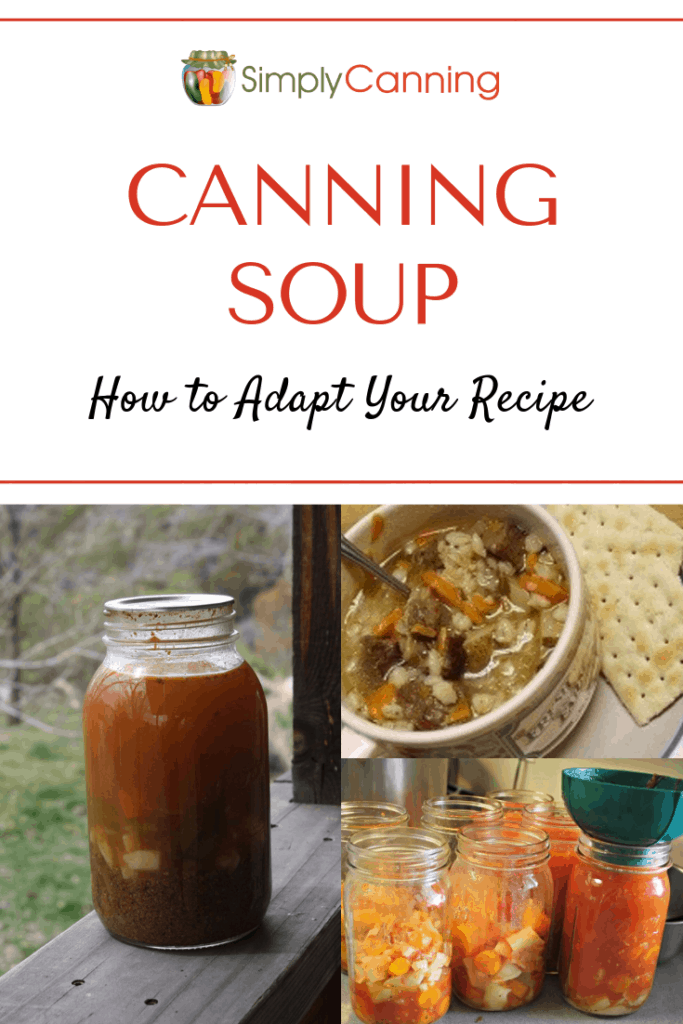
Source: The National Center for Home Food Preservation
Page last updated: 6/30/2021



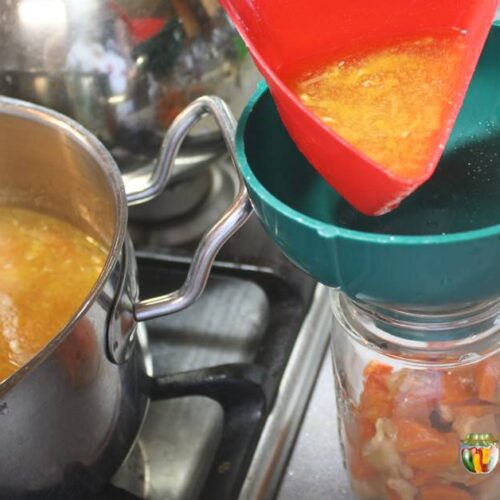
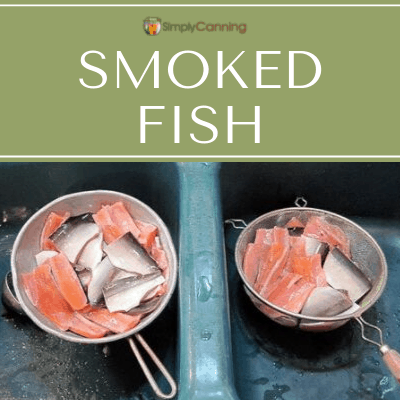
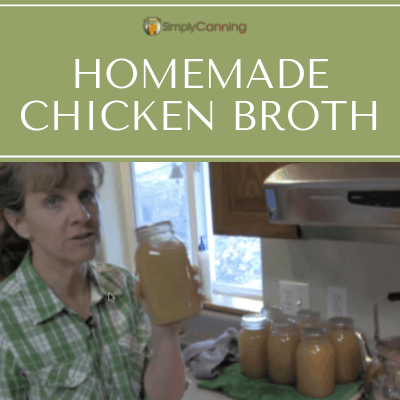
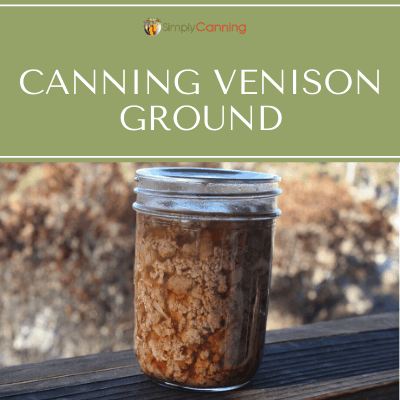
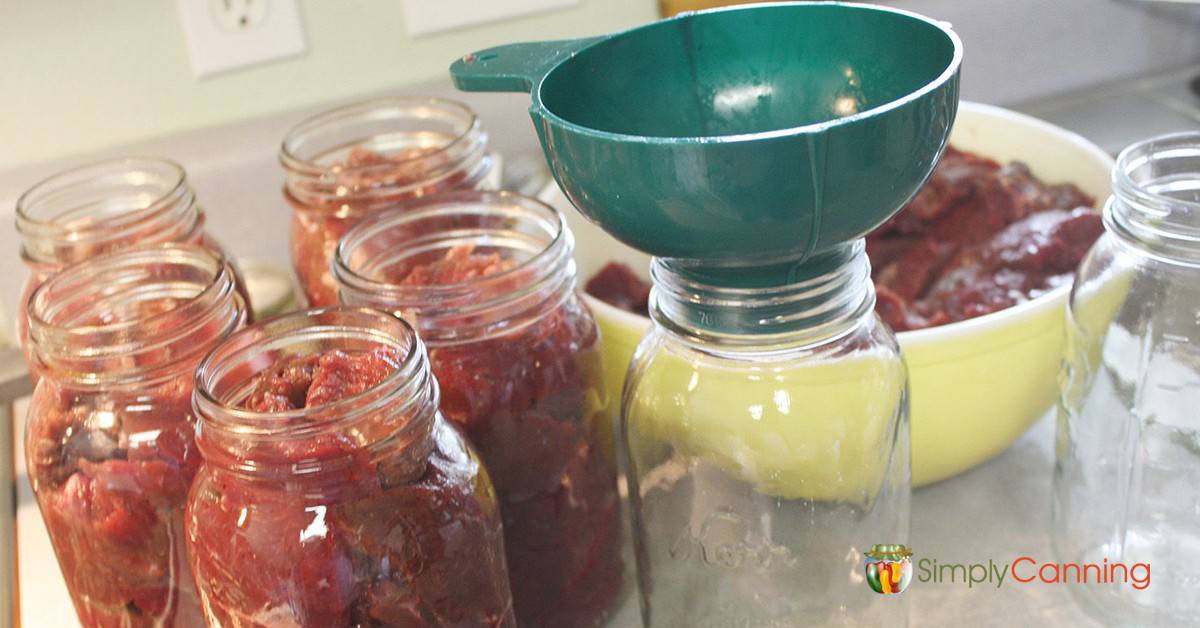


I skimmed my turkey fat and then Jared and pressure canned it for 40 min from a cold broth is this ok?
I’m not clear on what your question is. Do you mean you canned the fat? Or you were canning soup with turkey broth? Broth or soup is always canned from a hot pack. So no, you should have started the canning process with hot ingredients. Here is an article specific to canning broth.(turkey or chicken would be the same)
Hello, could I use a boxed chicken broth as my soup base?
Is it possible/advisable to add zucchini to a vegetable soup?
Does the processing time still need to be 75 minutes for quarts if there is no meat in the soup?
This is my first year ever canning and I appreciate your recipes!
Yes you can use boxed chicken broth as your base. Just check the ingredients and make sure it is just broth with no fillers or thickeners. No zucchini would not be appropriate for soup since it does not have a plain canning recipe. It is often pickled but there are no tested recipes for plain zucchini. You can read more about canning squash (both summer and winter) here. And yes, for these directions the processing doesn’t change if you don’t have meat. It is still the same.
I know the comment was old, but with regard to adding sausage to soup and having some oil floating in it. While you drained the bulk of the fat off, to get more fat off the cooked meat, after draining, run the sieve full of meat under a hot running tap. It will wash away quite a bit more fat. Drain well and use.
Hey, I’m sorry if this is the wrong place to ask, but I am new to pressure canning and i wanted to try canning my moms meat sauce. She uses Knorrs dry cream of mushroom soup mix. It looks like it has some wheat flour, skim milk, cornstarch, and thickener (locust bean gum). Can this dry mix be used in a pressure canner? Thanks
No, this dry mix can not be used in any canning process. Sorry! I know that’s not what you wanted to hear.
Ah, ok thanks. And, no that’s exactly what I wanted to hear. Really interested in my new pressure canner and what I can do. I also respect that there are do’s and don’ts, and I want to be sure I am safe. I canned some whitefish I caught and it worked pretty well. 3 of 4 cans were good, one smelled a little different/fishy, so I tossed it. Are there any for sure tells that something didn’t can properly? Thanks again
I have Ball jars and I want to put my turkey soup in them. Can I just do that and keep the until I’m ready to eat the soup?
Chris do you mean without processing them? You can use your jars to store your jars in the fridge just as you would with any leftover. Just a replacement for a plastic container or whatever.
But if you want to store them for longer than a few days you would want to follow the instructions above to make your soup. Remember… no pasta, no rice, no dairy. This is not a recipe for just canning leftovers. this is how to adapt a soup recipe to be appropriate for canning.
Should I add lemon juice to my vegetable soup
Pat, You can add lemon juice if you want to. But it is not necessary for safety as long as you follow the instructions on this page. The directions here have been tested so you can create your own soup recipe and be safe pressure canning it. Follow all instructions and lemon juice is not needed unless you want it for flavor. If it makes you more comfortable to use it for acidifying your mix, go ahead.
Do I leave canned soup out of the refrigerator? If it has been refrigerated can I leave it out afterwards?
Sarah, your question is kind of vague so it is hard to answer. The directions on this page are intended for soup in jars that you want to store on the shelf. So if you’ve followed the directions then you can put your jars in the pantry. After you’ve opened the jar if you don’t eat it all it would need to be stored in the fridge just like any other leftover. I hope that helps.
I made a very tasty veggie conglomerate stew, it has the 15 bean mix,barley,carrots, parsnips,turnips, backchoy, and potatoes in it .I live at between 6 and 8 thousand feet I have a pressure canner so no worries there, but I’m not sure about the canning times. Can you help. Thank you .
I would like to can soup for Manhattan clam chowder. I planned to make the soup a tomato vegetable base and add the clams and bacon later at the time of heating. Do potatoes can well and would I pressure can at the longest time of the vegetable that requires it? Also has anyone else tried this?
I would say just follow the soup directions on this page and it should work well. Check and be sure the ingredients are all acceptable for canning. Adding the clams and bacon later is perfect.
Does a soup that is completely cooked still need to go into a pressure cooker or can it be in a hot water bath. I apologize for such a basic question I’m new to this and learning. Thank you in advance
Hi Rachael, All soups must be done in a pressure canner. it sounds like maybe you want to preserve leftovers, that is actually not recommended. The veggies will be over cooked and can get mushy and cause heat penetration issues. You’d be better off freezing it if the soup is already cooked to completion. If you’ll notice, in the directions for canning soup you only partially cook the veggies. This is the way to properly prepare the soup for the canner.
Hi, Karen.
This recipe from Ball is a pureed carrot soup. Would it have been tested and safe since it is from Ball? I’m nervous because I just made it.
I also have a question about fish soup. I thought processing time for fish by itself was quite long- over 100 minutes. Is the 100 minutes less because of the density of soup vs the density of a jar packed with fish?
Thanks for your amazing site!!
If the recipe is from Ball I personally would trust it.
I’m not clear what you are asking about fish soup so if I misunderstood please ask again. 🙂 \\ Fish is a food that does have a long processing time. Here are the directions I have for canning fish. The processing time for soup with fish are longer also because of the length of time for the fish. Density is one thing that is tested when they come up with recommendations. The meat from fish is very different than other meats.
I need a good okra corn tomato soup recipe for canning
Help!. First time canning veg. soup over filled with veg. I have little liquid at the top. Can I correct this and re-pressure cook them again?
Delores this will depend on how long it has been since you noticed the issue. I talk about canning mistakes and how to handle them on this Canning Chat. Canning Mistakes: what should you do? Check that and see if it helps.
Came across this while researching soups in the pressure canner. Lucky find. Thank you for the info.
Hi I am thinking about making a broccoli soup using the small stems and small florets from the almost done broccoli plants of winter. I understand the reason for leaving whole or small pieces as apposed to pureed and will blend when taking out of the jar. I will be using broccoli, onions, maybe carrots, dry seasoning and chicken stock as the liquid. Can you give me an idea given these ingredients how long I should pressure can? Thanks in advance for your help.
Have you ever canned tomato soup? I have my own recipe that I love and want to can it and know people do can tomato soup but it’s a purée.
Hi, Jessica!
You could can your own plain tomato sauce, for example (directions here: https://www.simplycanning.com/canning-tomato-sauce/). However, most tomato soup recipes contain dairy, which isn’t safe for canning. I would suggest canning the tomatoes plain, and then adding other ingredients when you go to serve the soup. That’s what Sharon does for her tomato soup too: https://www.simplycanning.com/tomato-soup-recipe/
-Rachel (Sharon’s assistant)
I just read here that you can’t can cabbage or broccoli, is it safe if it’s in a vegetable soup in small amounts?
That is correct. Unfortunately, since cabbage or broccoli do not have canning instructions as an individual item you should not use it for canning your own soup recipe. If you find a tested recipe that has these ingredients it is ok because that particular recipe has been tested. But not for adapting your own soup recipe.
Can you can cooked soup? I have recently made a Kale, chicken lemon soup, then pressure canned. Also did blended mushroom as well as blended carrot squash. Thank you!
If you try to can fully-cooked soup the ingredients will be soft to start with. There may be concerns about the density of the soup affecting how the heat penetrates to the center of the jars so that will affect the safety of your soup. You need to follow the instructions above about how to prepare your ingredients and then combine them for preservation. Don’t forget the 1/2 solid and 1/2 liquid requirements. The blended soups are not recommended. You could can them chunky and then blend it when you open the jar to serve it.
Can I safely can broccoli soup if I leave the Broccoli in pieces and leave out the cream? When I open it I will add the cream and puree the broccoli then. I never see anyone can broccoli.
No, unfortunately, there is no method for canning broccoli so you can’t can soup out of it either. Freezing is a great option. These are the “rules” for canning your own soup recipes… Adapting your soup recipe for canning.
If I’d have scrolled down my question would have been answered LOL
Great site! Thanks for sharing!